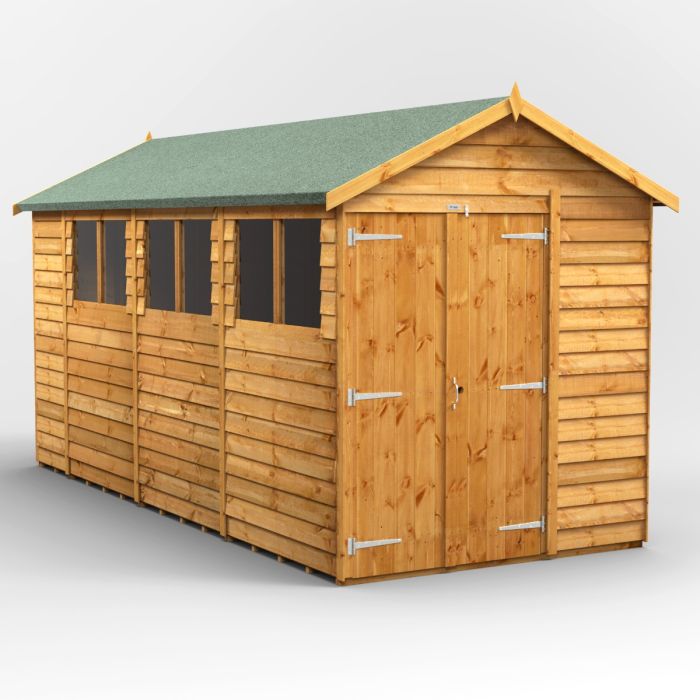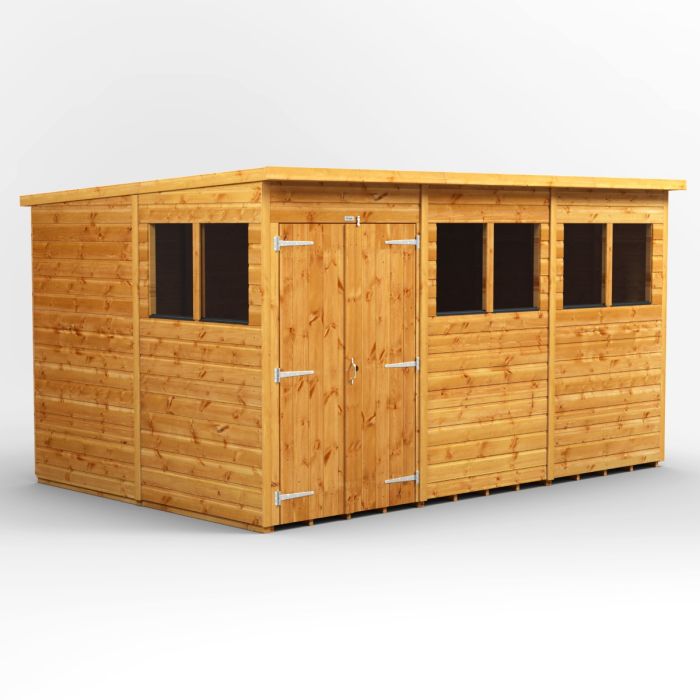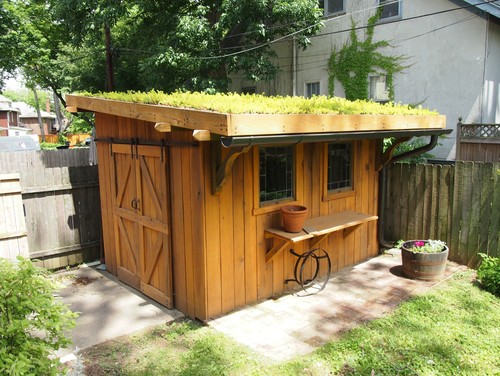Perhaps the most important aspect when looking to design or upgrade a shed is the
roof. Not only can it change the aesthetics of your garden, but choosing the right (or wrong!) garden shed roof design and materials can significantly impact the longevity and practicality of your shed.
In this post, we will explore some handy garden shed roof ideas, helping you to make an informed decision that suits your needs and your budget. From classic sloped roofs to modern natural options, there really is something for everyone on the market. On our journey into the world of shed roofing ideas, we will cover:
Factors to Consider
Before we begin exploring garden shed roof ideas, here are just a few considerations to help with your decisions as we move through the options:
- Pitch: Pitch refers to the angle at which your shed roof slopes. Typically, any roof with an angle above 10˚is classed as a pitched roof, and anything below that is a flat roof. If you have a pitched roof, you’re in luck! Since pitched roofs are more resistant to water ingress, you have a lot more choice when it comes to choosing materials.
- Level of Waterproofing: To avoid significant structural damage and damage to the stored items, your garden shed roof should be waterproof. Not only this, but you should aim to choose a roof which can also withstand snow and ice (who knows with British weather!)
- Aesthetics: No one wants an eyesore prevailing over their beautifully tended garden. You should consider which roofing materials fit with the appearance of your home and other aspects of your garden. Some options can come in multiple styles or colours to aid with this.
- Budget: When it comes to shed roofing, pricing can differ vastly. Consider all of your options – you may be able to find a similar look and level of performance for less!
- Durability: Ultimately, you probably want to maximise the longevity of your shed as much as possible without veering too far out of budget. Whichever style or material you choose should ideally be able to persist through years (and sometimes decades) of wear and tear.
- Maintenance: What level of maintenance are you willing to take on? Some shed roofing materials require much more care and attention than others – wood, we’re looking at you!
- Use: Not to be underestimated, the function of your garden shed will probably impact which roofing styles are most appropriate. For example, if you’re looking to get the most efficient use of interior space, pent roofing is probably your best option. However, if you’re more invested in comfortable head space and a cosy feel, apex designs may be better suited.
Exploring Garden Shed Roof Types
When it comes to the design, you can broadly expect to choose between two main options of shed roof types: apex and pent. When deciding between the two, there is not a definitive answer as to which style comes out on top. Both options have different functional advantages and aesthetic styles, so it really does come down to your individual preference, intended use, and desired price point.
Apex
An
apex shed is recognisable from its iconic sloped structure, meeting at a point (or apex!) at the top. Whilst often a bit more expensive than pent sheds, the traditional appeal of this design makes it suitable for many different garden styles, no matter where you place it.
The desirability of the apex-style shed roof is not limited to aesthetics either! With spacious headroom and enhanced airflow, it can prove great for garden sheds used for social or personal spaces,
like a garden bar, rather than storage. In addition, depending on the size and scale of the shed, an apex shed roof can offer additional attic storage, or even space for airy skylights.
Finally, the sloped design of apex sheds means that rainwater can easily flow off the roof, meaning that apex roofs have great performance in many different types of climates and weather conditions.
 14x6 Apex EZI Shed
14x6 Apex EZI Shed
Pent
Pent sheds offer a sleek single-sloped design which can lend itself well to minimalist and modern aesthetics. Whilst the simplicity might deter some buyers, a great pent shed roof has many benefits including relatively quick and straightforward installation and a more budget-friendly price point.
Functionally, pent shed roofs also ensure an efficient use of space, easily incorporated into small or narrow gaps. Inside, vertical space can be maximised, proving useful for individuals looking to store particularly large objects. Plus, the efficiency doesn’t stop there! The flat surface of pent shed roofs could provide the perfect space for installing solar panels, and even on less sunny days, you can be sure that the robust structural integrity of pent roofs will withstand adverse weather conditions.
 12x8 Pent EZI Shed
12x8 Pent EZI Shed
Material Matters
Now that we have explored shape, the next stage when considering different garden shed roof ideas is material. The material you select for the roof can make a huge difference in terms of durability, maintenance and aesthetic appeal. Also, different materials offer specific benefits, from low cost to ease of installation, and so it is important to consider various options before deciding which is the best shed roofing material for you.
The range of materials you have to choose from is firstly dependent on the pitch of your shed roof. As previously mentioned, this is because roofs classed as ‘flat’ are more at risk of penetrative damp, and so only certain materials can effectively protect the shed. Below, we have compiled a comprehensive guide to different material options for both flat and pitched roof types.
Flat Roofs
| Material |
Cost |
Installation Difficulty |
Max Years |
Extra Information |
| Roofing Felt |
£ |
Easy |
10-30 |
Sleek, smooth and uniform look great for modern spaces.
Usually supplied in rolls which can be cut to size. |
| EPDM Rubber |
££ |
Easy |
50 |
Provides a particularly clean finish.
The singular large sheet format minimises weak points for water penetration. |
Pitched Roofs
| Material |
Cost |
Installation Difficulty |
Max Years |
Extra Information |
| Bitumen (Sheets) |
£ - ££ |
Easy |
20
|
A simple, charming and versatile aesthetic.
Onduline is a particularly eco-responsible supplier using low-energy manufacturing processes and recycling 60,000 tons of material a year.
|
| Polycarbonate (Sheets)
|
££ |
Easy
|
10-20 |
A light and airy look.
Particularly great for simple, lightweight garden structures. |
| Metal (Sheets and Shingles) |
££ - £££ |
Medium |
25 |
Sleek, sophisticated and flexible aesthetics.
Sheets are typically available in both box profile and corrugated styles. |
| Clay (Tiles) |
££££ |
Hard |
60+ |
Rustic and authentic appearance.
Weight means it is generally unsuitable for less stable, lightweight sheds. |
| Felt (Shingles) |
££ |
Easy - Medium |
10 |
Adaptable and customisable to current features.
A highly sought-after material, particularly great for budget projects. |
| Rubber (Shingles) |
££ - £££ |
Easy - Medium |
50 |
A simple yet versatile aesthetic.
Has become more popular in recent years, likely due to its eco-friendly nature.
|
| Wood (Shakes and Shingles) |
£££ |
Medium -Hard |
20 - 30 |
Leaves a warm, rustic and traditional impression.
Better for sheds with a steeper pitch: around 14˚for shingles, or 20˚ for shakes. |
Feeling Adventurous?
In recent years, there have been new and exciting additions to garden shed roof ideas, particularly when it comes to green options:
Green Roofs
Green roofing refers to those wholly or partially covered in vegetation. Not only can this be eye-catching and unique, but it is also a great option to help support garden biodiversity. However, the sheer number of layers it requires to ensure that the shed roof is both structurally sound and effective at keeping the vegetation alive means that this is a particularly costly venture.
Photo by Graham Design Build - Source:
Houzz
Artificial Grass Roofs
Thankfully, if you’re looking for the striking aesthetics of a green roof without the hassle of maintaining one,
artificial grass can be the next best thing. Whilst it doesn’t have the same impact on biodiversity, when done right, artificial grass roofs can look great and remain durable for up to 25 years.
The Best Garden Shed Roof Ideas for DIY
DIY can be a great way to save on installation costs, but it is vital that you balance your aesthetic goals with practicality. Any
sheet options (polycarbonate, metal or bitumen) are probably the best call, since they require less intricacy in the installation process, but if you’re looking for a more complex look, the material should be easier to work with. So, for pitched roofs,
felt or rubber shingles could both be great options.
Creating a custom garden shed roof can be a really rewarding project, but you should aim to balance style with functionality and consider where your strengths lie! If DIY isn’t your thing at all, you may also prefer a pre-made shed. Our
garden shed comparison guide can help to narrow down your decision.
Wrapping Up On Our Garden Shed Roof Ideas
Phew! Well done on getting all the way to the end of this guide to garden shed roof ideas. Let’s quickly run through a few final thoughts.
- Choosing the right roof for your garden shed is key to ensuring its durability, practicality and aesthetic appeal.
- Whether you go for a sleek and simple felt flat roof, a beautiful and complicated clay shingle pitched roof, or even a mini-garden green roof, there is a style and material to fit every need and budget.
- By considering factors such as weather resistance, cost and overall aesthetic, you can make your shed roofing idea come to life in a way that not only protects your shed but also enhances your garden space.
- With the right design and materials, your garden shed will continue to serve you well for years to come.
Now you’ve made it this far, why not explore our
sheds, or get cracking with our range of
roofing materials?
 14x6 Apex EZI Shed
14x6 Apex EZI Shed
 12x8 Pent EZI Shed
12x8 Pent EZI Shed
 14x6 Apex EZI Shed
14x6 Apex EZI Shed
 12x8 Pent EZI Shed
12x8 Pent EZI Shed

 Processing
Processing